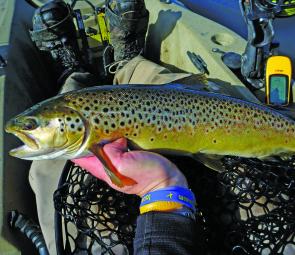If unpredictability needed a more suitable word companion, then I can think of none other than spring!
We have been given a bit of a hammering in the rain department (again) and winds have done their fair share of blowing. That’s ok though, just plan to go inside and when you come back out the sun will be shining – briefly! Huey certainly keeps us on our toes at this time of year, but luckily the trout are still there and they are still looking for tucker.
Late last month before the rains hit, I managed an outing to a local creek and spent the afternoon sight fishing to tiny brown trout. I caught a few on small Royal Wulff’s and most fish I came across were very obliging.
It was interesting to watch two above-average fish sitting next to each other behaving oddly. They were chasing each other about and nipping each other. I first thought they may be late spawners as they were browns but after the umpteenth cast one fish finally took the dry; maybe I annoyed it!
Overall, the rivers have copped two floods in very quick succession, waters barely had time to get back to normal levels when massive rains helped them burst the banks a week later. We were barely into September and the rains topped them up again.
I had a quick fish on the lower Meander River one afternoon but there was far too much water around. I spoke to a pair of anglers that caught some average browns on dry flies here before the paddocks became too moist. You really have to make the most of well-timed outings to score this flood fishing caper!
I also had a friend that caught some nice fish on the North Esk using the Earthworm fly, created by local guru Patrick Horan. I’ve tied a few of these flies up but struggle to get the opportunity to put them in front of suitable fish!
Despite the constant flushes of freshwater, Northern Rivers like Tamar, Great Forester, Mersey, Forth and Leven all have whitebait present and there have been anglers already catching small searun brown trout. Even some of the lesser-known little creeks have their own small-scale whitebait run, so be sure to explore that enticing little water as you drive past!
Many anglers have experienced a love/hate relationship with Four Springs, as it has been a bit up and down, much like the weather. Local tackle store manager Nick Martin scored himself a 10lb specimen on the fly a few weeks back. It’s amazing to think that despite the heavy stocking on this water, it still manages to produce trophy fish each year.
John Clark has also been having some fun with rainbow trout there in his kayak. Four Springs is an ideal water for fishing out of the ‘yak and you often see an increasing number paddling about our waterways, which is great.
Huntsman Lake has been very high and word on street is that if you get there early enough, you’re bound to see some tails waving about. It’s a small window of opportunity though as the lake is only open from one hour before sunrise and the hot tip is that fish will move into deeper water as soon as the sun is up. The early fish gets the worm!
Anglers I have spoken to have experienced success using stick caddis, black beetle and 007 patterns. You could probably try Pattos Earthworm fly here too, as many trout have been gorging themselves on them. Tailing activity will probably taper off as the water warms up a bit though.
For those who are interested, Brushy Lagoon received a stocking in August of Atlantic salmon to 3kg and rainbow trout over 5kg. No doubt many have already been captured but a surprising number lurk around for some time.
It’s a fantastic time of year to be tangling with a trout, with so many significant events on the calendar. One of those being the mayfly hatch which usually coincides with Launceston Show Day, or around this time. We are usually coming out the other side of the cooler frosty mornings and the days can begin to warm up to 20-22ºC.
These are ideal conditions for the mayfly ‘nymph’ to start making its way from the riverbed or lake bottom, to ascend upward into the surface film where they clumsily hatch into the second mayfly stag, the revered ‘dun’.
Once this has occurred, the dun then bobs along the water like a little sailboat and if it’s lucky enough to escape the jaws of a hungry trout and reach the shoreline, it will clamber up onto reeds or trees where it then hatches into an adult mayfly, the ‘spinner’.
After this, the mayfly mates all in the name of species survival and then dies; it’s a short life span, isn’t it?
This process is very unique among the insect world and anglers get very excited at the prospect of sight fishing to trout that are feeding on these very mayflies.
Reads: 1236





